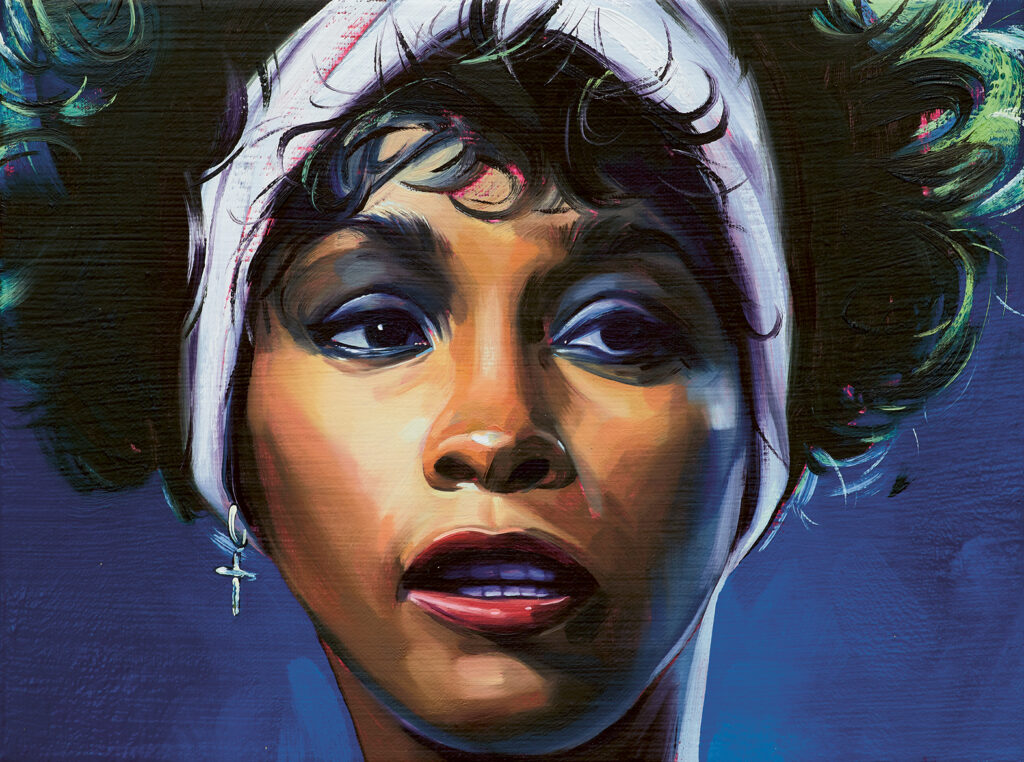Sam McKinniss, Star Spangled Banner (Whitney), 2017. Courtesy of the artist.
1. The Divine Celebrity
“There isn’t really anybody who occupies the lens to the extent that Lindsay Lohan does,” the artist Richard Phillips observed in 2012. “Something happens when she steps in front of the camera … She is very aware of the way that an icon is constructed, and that’s something that is unique.” Phillips, who has long used famous people as his muses, was promoting a new short film he had made with the then-twenty-five-year-old actress. Standing in a fulgid ocean in a silvery-white bathing suit, her eyeliner and false lashes dark as a depressive mood, she is meant to look healthily Californian, but her beauty is a little rumpled, and even in close-up she cannot quite meet the camera’s gaze. The impression left by Lindsay Lohan (2011), Phillips’s film, is that of an artist’s model who is incapable of behaving like one, having been cursed with the roiling interior life of a consummate actress. Most traditional print models can successfully empty out their eyes for fashion films and photoshoots, easily signifying nothing, but Lohan looks fearful, guarded, as if somewhere just beyond the camera she can see the terrible future. Unlike her heroine Marilyn Monroe, Phillips also observed in a promotional interview, Lohan is “still alive, and she’s more powerful than ever.” It is interesting that he felt the need to specify that Lohan had not died, although ultimately his assertion of her power is difficult to deny based on the evidence of Lindsay Lohan, which may not exude the surfer-y, gilded vibe he might have hoped for, but which does act as a poignant document of Lohan’s skill, her raw and uncomfortable magnetism.
“Lindsay has an incredible emotional and physical presence on screen that holds an existential vulnerability,” Phillips argued in his artist’s statement, “while harnessing the power of the transcendental—the moment in transition. She is able to connect with us past all of our memory and projection, expressing our own inner eminence.” “Our own inner eminence” is an odd, not entirely meaningful phrase, used in a typically unmeaningful and art-speak-riddled press release. What the artist seems to say or to imply, however, is that Lohan’s obvious ability to reach inside herself and then—without dialogue—vividly suggest her depths onscreen acts as a piquant reminder of our own complexity, the way each of us is a celebrity in the melodrama of our lives.
What makes Lindsay Lohan art and not a perfume advertisement, aside from the absence of a perfume bottle? The same quality, perhaps, that makes—or made—Lohan herself a star, as well as, once, a sterling actress. All Phillips’s talk of transcendence and the existential may be overblown, but then stars tend to be overblown, as evidenced by the superlatives so often used in descriptions of Hollywood and its denizens: “silver screen,” “golden age,” “legendary,” or “iconic.” “Muses must possess two qualities,” the dance critic Arlene Croce claimed in The New Yorker in 1996, “beauty and mystery, and of the two, mystery is the greater.” At first blush, Lohan might not have seemed like an especially mysterious muse, with her personal life splashed across the tabloids and her upskirt shots all over Google. In fact, her revelations are a trick, the illusion of intimacy possible because she has enough to plumb that we can barely touch the surface. We can see her pubis and her mugshots and the powder in her nostrils, but it is impossible for us, as regular, unfamous people, to know what it feels like to be her.





